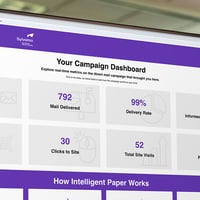Mottle, Cockling and Show-Through: How the Right Paper Can Help You Avoid These (and other) Types of Print Defects

The smallest design decisions can make the biggest difference in the effectiveness of your printed projects. Between paper weight, opacity and coating, the wrong choice can result in printing defects that could not only hit your marketing budget, but also the way that your customers perceive the value of your brand and collateral.
While such print defects may seem like an issue solely reserved for printers, designers who understand the causes of common defects can be proactive by specifying the right sheet for their projects or by making design decisions that can help prevent these issues from occurring.
With this in mind, let’s look at a few of the more common paper-based print defects, and how partnering with Accent® Opaque can help ensure high-quality print in any application.
What are some common print defects?
While this is in no way a comprehensive guide to print defects, these are some of the more common defects commercial printers and designers encounter, and understanding what these defects are and how they happen is a good start toward creating print projects with performance and longevity in mind.
Mottle
One of the most common paper-based print defects in mottling, which simply put means that print appears uneven or simply “blotchy” in appearance, with certain areas not being evenly reproduced. The most common form of mottle is back trap mottle, which is when there’s an uneven transfer of the ink to the surface of the paper, which leads to a cycle of an uneven transfer back onto the blankets of the next printing units.
Curling
Paper curling is exactly what it sounds like — paper comes out of the printer more curled than flat, which jeopardizes the structural and visual integrity of your printed piece. While excess moisture and heat in areas where paper is stored can cause this to happen, the most likely scenario is that the quality and weight of the paper wasn’t sufficient for the job at hand.
Cockling
In printing, cockling refers to a wrinkling or deformation of the paper, usually in areas of high ink coverage. This can happen for a couple of different reasons. First, there is the structural property of the paper in relation to the ink load. If too much ink is used on a paper that has too low of a weight, the excess ink will cause the paper fibers to expand during the drying process, which will cause the paper to ripple or cockle.
Cockling can also occur due to fluctuations in temperatures and humidity, with higher drying temperatures resulting in higher instances of cockling. Many instances of cockling can be avoided by using a heavier weight of paper that can take on a higher usage of ink.
Show-through
As the name would suggest, show-through is when text and/or images printed on one side of a sheet are visible on the opposite side, which often results in reduced readability and the quality of a printed piece. This occurs most often when using thinner, lighter, coated papers where there is less pulp and lower opacity,
Bleeding
Bleed-through is when the ink seeps from one side of a printed page to the other, or when the ink extends beyond the edge of the paper, greatly reducing the print quality. The most common cause of bleeding is choosing a paper that isn’t up to the job. If it’s low quality and too thin and light, there’s less fiber and weight for the paper to absorb the ink, which will cause it to bleed through.
The paper’s finish is also a factor, as glossy paper will smudge and bleed much easier than that with a matte finish, which more easily absorbs the ink.
How to avoid paper-based print defects
Many of the most common paper-based print defects can be easily avoided by selecting the highest-quality paper stock available. While different projects will require different paper specifications — such as thickness, finish and durability — using a lower-quality paper stock may result in a variety of paper-based print defects that can cause a significant hit to your marketing budget and even your reputation.
Our premium, uncoated sheets feature a smooth, level printing surface that allows for crisp, vivid images and consistent production, with excellent opacity for minimal show-through and transparency. Our dedication to quality paper formulation also applies to The Heavyweights, our new line of heavyweight paper stocks, to help you create print collateral where durability and a more sensory experience are key.
Learn more about how Accent Opaque premium paper can help you design and print high-quality pieces that take your marketing materials to a new level.





